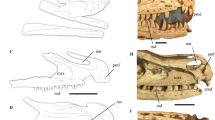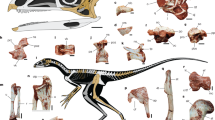The other component of this infamous fossil forgery is identified as a fish-eating bird.
Abstract
The 'Archaeoraptor' fossil, once proclaimed as a key intermediate between carnivorous dinosaurs and birds1 but now known to be a forgery, is a chimaera formed of bird and dromaeosaur parts2,3. Although the non-avialan dinosaur tail of this controversial specimen from the Early Cretaceous Period of China has been identified4, the avialan parts of the specimen have not. Here we reveal that these avialan parts, including the hindlimbs, which were previously designated as unverifiable “attached bones”3, can be referred to a single species, Yanornis martini5, and are supported as pieces of a single, almost complete specimen. A new specimen that is also referable to this species, and which has its gut contents preserved, indicates that the principal part of this false raptor dinosaur–bird fossil is in fact a fish-eating bird.
Similar content being viewed by others
Main
High-resolution computed X-ray tomography revealed that two to five specimens belonging to two or more species could comprise the Archaeoraptor forgery3. However, the morphology and proportions of all of these parts, other than the dromaeosaur tail, supports referral to a single species, Y. martini5. Measurements (see supplementary information) and anatomical features of the Archaeoraptor parts correspond closely and, taking breakage into account, are almost identical to those of the Yanornis holotype.
The premaxillae are partially fused and toothed in both specimens (Fig. 1). The tip of the exposed right premaxilla of the Archaeoraptor specimen lacks associated teeth. The length of this portion of the facial margin is identical to that of the edentulous portion of the premaxilla in the Yanornis holotype. In both specimens, the coracoid has a prominent procoracoid process and deeply concave scapular cotyla (Fig. 1). These skull and pectoral-girdle features are preserved as impressions in the Archaeoraptor specimen (Fig. 1a). Both preserve prominent lateral processes of the coracoids, as well as extremely robust furculae ('wishbones'). The combination of the aforementioned morphologies is unique to Yanornis, and the dimensions of these elements are equivalent (Fig. 1b).
a, Front half of the Archaeoraptor specimen IVPP V12444 (excluding the tail); b, front half of the Yanornis martini holotype specimen IVPP V 12558, shown for comparison; inset, gut contents of a new Yanornis specimen, IVPP V13259. ed, edentulous portion of premaxilla; fe, femur; fr, fin rays; fu, furcula; lp, lateral process of coracoid; op, teleost fish opercular fragments; pm, premaxilla; pr, procoracoid process of coracoid; ri, ribs; sc, scapular cotyla of coracoid; st, sternum; ve, teleost fish vertebra. Scale bars, 2 cm. For further data used in the analysis, see supplementary information.
The dimensions of the femur, tibia and tarsometatarsus, as well as the lengths of the pedal phalanges, are also nearly identical and are consistent with referral of these parts to Yanornis (see supplementary information). The foot shares with the Yanornis holotype morphological features, including proximal and distal fusion of metatarsals II–IV, and metatarsal II being shorter than IV.
On the basis of the presence of a combination of morphologies unique to Y. martini in the associated front part of the Archaeoraptor specimen listed here, we refer this portion of the specimen to that taxon. Because of the correspondence in measurements and morphology, the hindlimb elements are identified as being consistent with these separate blocks that make up parts of a single Yanornis specimen. The avialan portion of the Archaeoraptor specimen also provides further evidence of the anatomy of Y. martini. For example, it preserves a distally tapering scapular blade, a short, slightly recurved acromion, and remnants of an anteriorly developed sternal keel, features that are not preserved in the holotype.
A recently discovered specimen of Yanornis (IVPP V13259) contains preserved macerated fish remains, including a teleost vertebra, fin rays and opercular fragments (Fig. 1b, inset), and is only the second bird from the exceptionally diverse Jehol Biota6,7 to be discovered with its gut contents preserved. The principal portion of the Archaeoraptor forgery, which we conclude was constructed from two different specimens belonging to two different species, is therefore representative of a fish-eating bird.
References
Sloan, C. P. Natl Geogr. 196, 98–107 (1999).
Dalton, R. Nature 403, 689–690 (2000).
Rowe, T. et al. Nature 410, 539–540 (2001).
Xu, X., Zhou, Z. & Wang, X. Nature 408, 705–708 (2000).
Zhou, Z. & Zhang, F. Chinese Sci. Bull. 46, 371–377 (2001).
Zhang, M., Chen, P., Wang, Y.-Q & Wang, Y. (eds) The Jehol Biota (Shanghai Sci. Technol., Shanghai, 2001).
Zhou, Z. & Zhang, F. Nature 418, 405–409 (2002).
Author information
Authors and Affiliations
Corresponding author
Ethics declarations
Competing interests
The authors declare no competing financial interests.
Supplementary information
Rights and permissions
About this article
Cite this article
Zhou, Z., Clarke, J. & Zhang, F. Archaeoraptor's better half. Nature 420, 285 (2002). https://doi.org/10.1038/420285a
Issue Date:
DOI: https://doi.org/10.1038/420285a
This article is cited by
-
Linking geological heritage and geoethics with a particular emphasis on palaeontological heritage: the new concept of ‘palaeontoethics’
Geoheritage (2021)
-
Study on the Jehol Biota: Recent advances and future prospects
Science China Earth Sciences (2020)
-
X-ray computed tomography datasets for forensic analysis of vertebrate fossils
Scientific Data (2016)
-
Competition and constraint drove Cope's rule in the evolution of giant flying reptiles
Nature Communications (2014)
-
The ornithologist Alfred Russel Wallace and the controversy surrounding the dinosaurian origin of birds
Theory in Biosciences (2013)
Comments
By submitting a comment you agree to abide by our Terms and Community Guidelines. If you find something abusive or that does not comply with our terms or guidelines please flag it as inappropriate.




